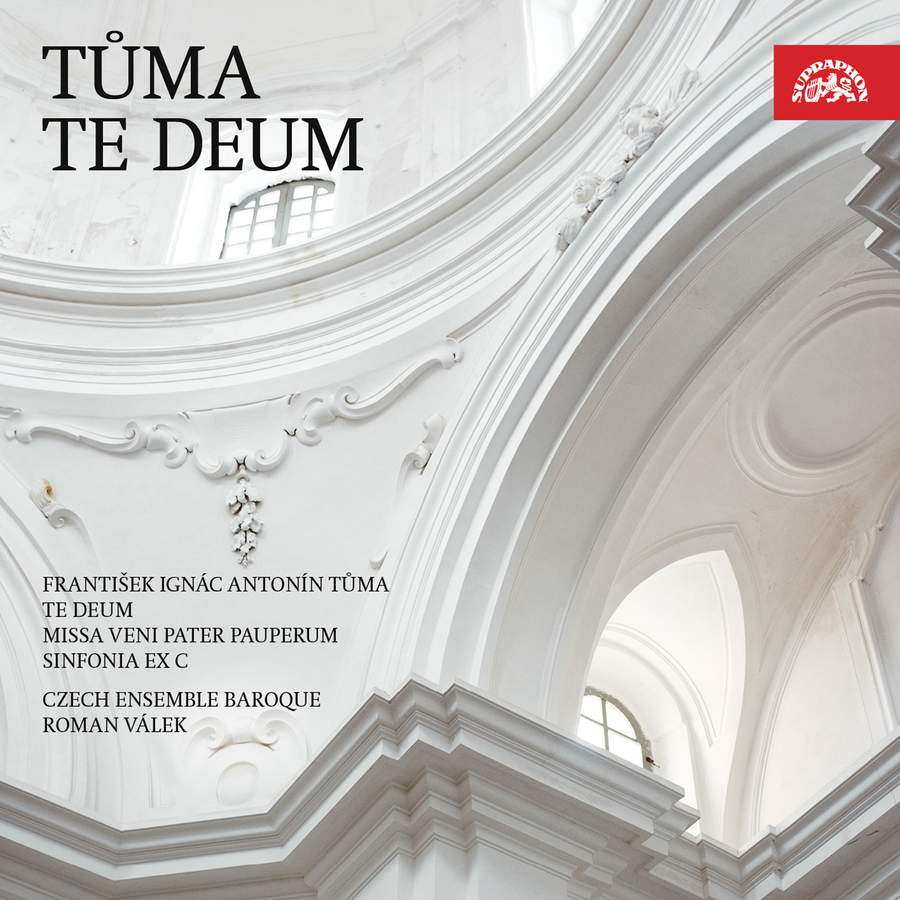Tůma: Te Deum
Czech Ensemble Baroque, Roman Válek
Supraphon SU 4315-2. 54’11

Te Deum (1745)
Sinfonia ex C (1770s?)
Missa Veni Pater pauperum (1736)
This is a very welcome recording of music by František Ignác Antonín Tůma (1704-1774), a little-known composer outside of the Czech Republic. He was born in Bohemia-born and was active during the transitional period between the Baroque and the Galant and Classical eras. After early studies in Prague, he spent most of the rest of his life in Vienna, initially as Kapellmeister for Count Kinsky, the High Chancellor of Bohemia, who encouraged him to study with Johann Joseph Fux, the influential theorist who also influenced Haydn, Mozart and Beethoven. After Kinsky’s death, he became Kapellmeister to the dowager Empress, the widow of Charles VI. In addition to his composing activities, he was also an organist, bass gambist and theorbist
The three pieces cover the bulk of Tůma’s life, from 1736 to the last decade of his life in the 1770s. They are not presented in chronological order, but that is easily remedied when listening, which I would recommend. The extended and festive 1736 Missa Veni Pater pauperum the longest piece on the recording, at around 32 minutes, and displays the strongest elements of the Baroque era in much of its musical structure and texture. It is one of several mass settings composed during Tůma’s time with Count Kinsky for performance in Vienna’s Schottenstift, a key Benedictine Abbey in the city centre named after the Irish (Scotia Major) monks that had earlier founded a church in Regensburg.
The music demonstrates the influence of Fux (then organist at the Schottenstift) notably in his masterful use of polyphony. The use of instruments points forward in musical textures, notably as first heard in the Qui tollis peccata munda, with its innovative use of brass. The et incarnatus est has a similarly colourful instrumentation. Only two of the movements are longer than two minutes, the whole making for a series of little essays in late Baroque compositional style. It is no surprise that it was performed many times in the Schottenstift.
The Te Deum was composed about ten years later, in 1745. Although this was when Tůma was in service to the dowager Empress, it was composed independently for the Stift Wilhering monastery overlooking the Danube just west of Linz in Upper Austria. It had a larger orchestra than Tůma had been used to in Vienna, and he made good use of the enlarged forces. It is a short but powerful piece, with trombones added to the texture and a spectacular opening salvo from the timpani and a tiny movement for two trombones. There is a definite move away from the Baroque idiom.
The four-movement Sinfonia ex C seems to have been composed towards the end of Tůma’s life, sometime in the 1770s. It has a similarly festive mood to the other two pieces on the CD, helped by the use of two clarini trumpets. It also represents a move towards the Classical era symphonic form.
The vocal soloists are Romana Kružíková, Pavla Radostová, sopranos, Monika Jägerová, alto, Jakub Kubín, tenor, Jiří Miroslav Procházka, bass. The singing is generally impressive although there are some moments when intonation could have been a bit tighter. The chorus adds a further seven singers to the soloists The instrumentalists of the Czech Ensemble Baroque, under conductor Roman Válek, make an impressive sound. Although the organ is a little chamber organ rather than a proper organ, it is good to actually hear it. The acoustic of the recording church, St Michael’s (Kostel svatého Michala) in Znojmo, near Brno) is friendly and probably matches the acoustics that Tůma would have known in Vienna. The CD booklet includes a carefully worded essay, revealing how conjectural are the aspects of Tůma’s life story.
